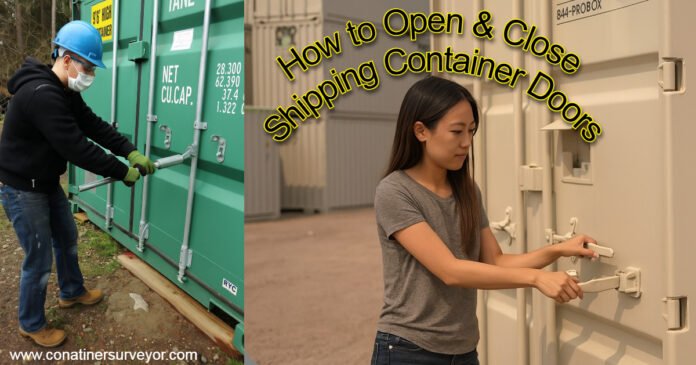Table of Contents
Before we learn how to open and close shipping container doors, let’s first look at the Shipping Container Door Structure Overview
01. Shipping Container Door Structure Overview
Most standard shipping containers are equipped with two cargo doors located at one end typically referred to as the left door and right door. However, depending on the design and intended use, some specialized containers may have no doors or additional side doors for flexible cargo operations. In this article, we focus on the standard two-door shipping container, which is the most commonly used in global logistics.
Opening and closing container doors may look simple, but in reality, it can be challenging, especially if the container has been in service for a long time. Before learning how to open and close a shipping container door, it is essential to understand:
- What a cargo container door is
- How the structure of the cargo door works
- The main components involved in marine container door operation
We have previously covered the above points in the article of “The Secrets of Shipping Container Doors” Before explaining how to open and close shipping container doors, we will briefly review the door structure and essential container door components,

Shipping Container Door Handle Catch
- Holds the door handle firmly in the closed position.
- Prevents accidental opening during transport or handling.
- There are normally four door handle catches in total two on each door.
Shipping Container Door Handle Retainer
- Holds the handle in the open position during loading or unloading.
- Prevents the handle from swinging freely or hitting the user.
- There are also four door handle retainers on a standard container two on each door.
Container Door Handle
- A standard container has two locking bars per door, meaning four door handles in total (Each locking bar has one door handle attached to it)
- Handles are located vertically on the outer face of each door, near the edge where the doors meet.
- Used to rotate the locking bars, which engage or disengage the locking cams and keep the door securely closed or open during operation.
Container Locking Bar Guide
- Each locking bar passes through two or more guides fixed to the door.
- These guides support and align the locking bars during operation.
Container Door Slam Plate (Door Stop Plate)
- Fitted on the door frame of the container, where the door edges make contact when closed.
- Acts as a protective plate to absorb impact when the door is shut.
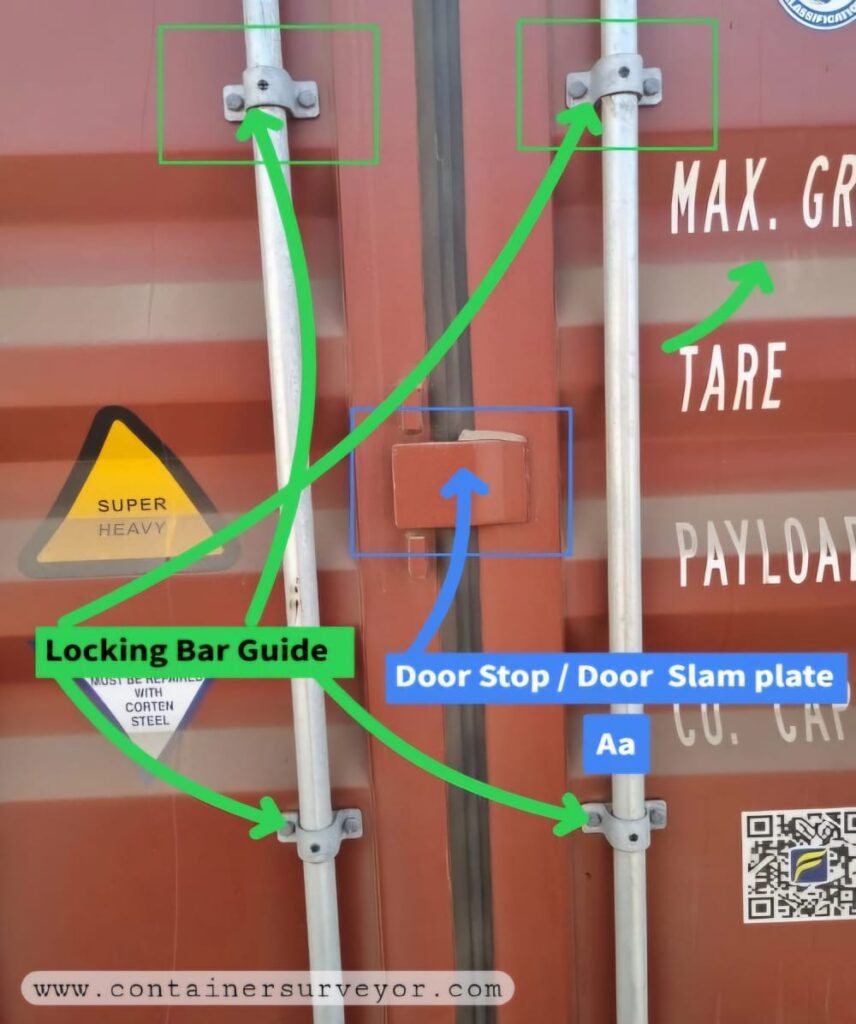
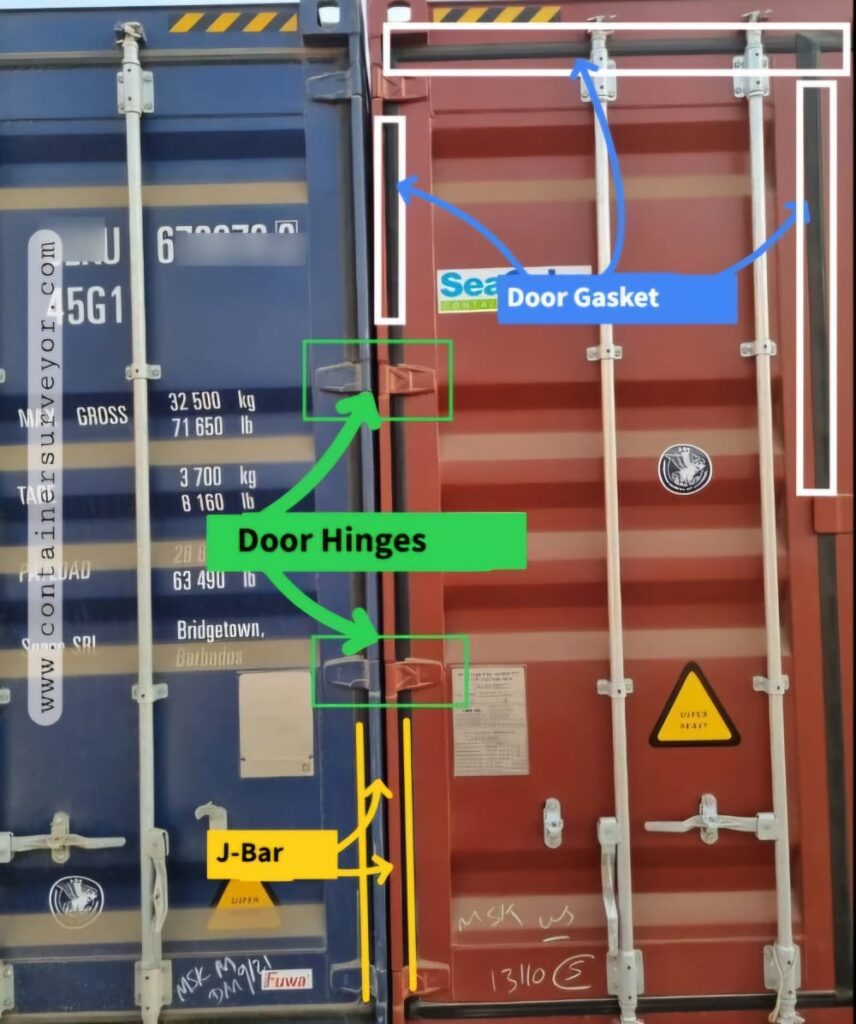
Container Door Gasket
- A rubber sealing strip fitted around the inside edges of each door.
- Provides a watertight and airtight seal when the doors are closed
- Prevents entry of water, dust, and light into the container.
- Runs continuously around the door perimeter.
Container Door Hinges
- Each container door is mounted using four or more heavy-duty hinges.
- Hinges allow the doors to swing open and close smoothly.
- They are welded to the door and corner post for strength and durability.
Container J Bar
- The J bar is the part of the outer corner post that extends from the rear edge of the corner post and wraps around the door hinges.
- There are two J bars on a standard container one on the left rear corner and one on the right rear corner.
Container Door Hold Back Cord
- A rope-type cord used to secure the door in the fully open position during loading or unloading.
- Prevents the door from swinging freely or slamming shut due to wind or movement.
Container Locking Bar Cam
- A curved metal fitting welded near the ends of the locking bar.
- Engages with the cam keeper when the handle is turned, locking the door securely in place.
Container Locking Bar Cam Keeper
- A slot that holds the locking bar cam when the door is locked.
- Mounted on the container door frame, not on the door itself.
- Works together with the cam to securely fasten the door.
Container Locking Bar Bracket
- A support bracket that holds the locking bar in position on the door.
- Allows the bar to rotate smoothly during opening and closing.

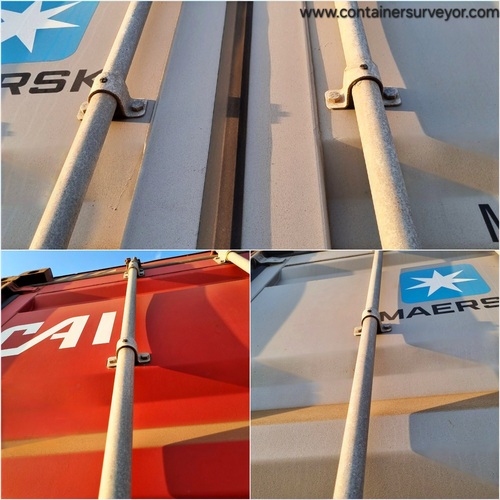
Container Locking Bar / Locking Rod
- A vertical steel rod fitted to each container door, used to lock and unlock the door.
- Rotated by the door handle to engage or release the cams and cam keepers at the top and bottom.
- Each door typically has two locking bars, making four in total for a standard container.
Container Locking Bar Assembly
A complete unit made up of the locking bar (rod) and all its connected parts including handles, cams, cam keepers, brackets, catches, and retainers.
02. Things to Check Before Opening a Shipping Container Door
When a container is loaded, there are several important safety and operational checks you must carry out before attempting to open the doors.
2.1 Check the Shipping Container Seals

As the consignee, your first responsibility is to ensure that the shipping container seal (container security seal) is intact and has not been damaged or tampered with. Next, verify that the seal number matches the number indicated on your shipping documents.
Action:
Before opening, remove or cut the shipping container seal carefully. This step is essential to begin the container door-opening process.
2.2 Inspect the Exterior & Door Condition

Inspect the exterior of the container for any visible bulges, dents, or structural deformations.
Pay close attention to the door components, as any damage to hinges, locking bars, or corner posts may affect door operation. Some cases components are missing
Action:
If any damage is observed, take clear photographs and inform your shipper immediately, unless the port has already confirmed that the damage existed during vessel unloading or before release to the consignee.
This will help you avoid unnecessary charges incurred under your account.
2.3 Check for Dangerous Goods (DG) Labels / Container Fumigation Labels

Check for Dangerous Goods (DG) Labels
Before opening, always inspect the container’s exterior for Dangerous Goods (DG) stickers or hazard labels.
If any DG markings are visible, do not attempt to open the container unless you are authorized and trained to handle hazardous materials. Unauthorized handling of DG containers can lead to serious health, safety, and environmental risks.
Check for Fumigation Labels or Notices
Before opening, look carefully for any fumigation labels, warning notices, or gas residue signs on the container doors or side panels.
If a fumigation notice is present, do not open the container until it has been certified as safe and ventilated by authorized personnel.
Opening a fumigated container without clearance can expose you to toxic gases or chemical residues.
2.4 Wear Appropriate Safety Gear

Always wear the recommended Personal Protective Equipment (PPE) such as,
- Safety helmet
- Gloves
- Safety Shoes
- Protective Glasses
These will protect you from potential injuries caused by sudden door movement, rust flakes, or falling objects.
2.5 Use the Correct Tools
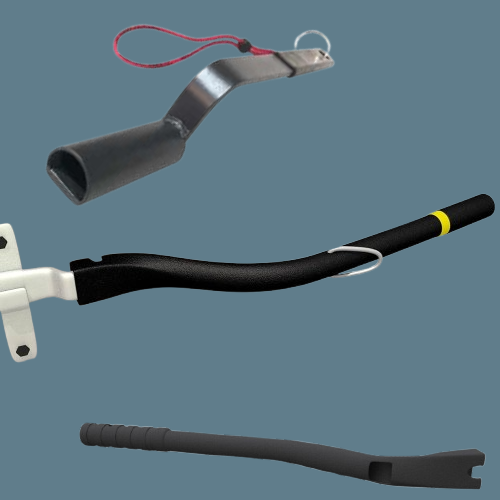
Always use proper shipping container door opening bar such as door handle levers or bar spanners specifically designed for container doors.
Avoid using pipes, hammers, or any makeshift tools, as they can easily damage the locking bars, handles, or cam mechanisms, and may even cause accidents due to tool slippage.
Now you are in a safe position and equipped with the right tools to operate the container doors properly.
2.6 Check the Ground Level and Clearance Space
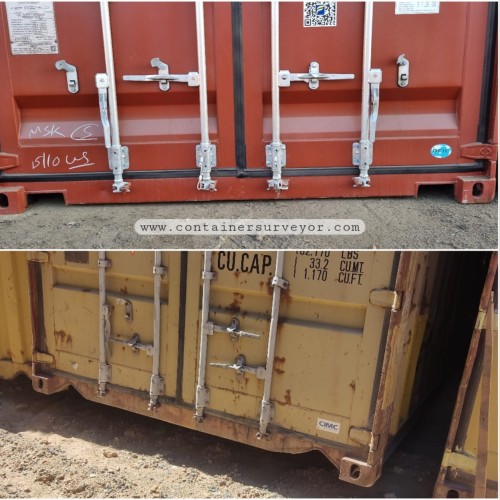
Make sure the container is placed on level ground and that there is enough space for the doors to swing open fully and safely.
Action (Cause):
If the container is not on level ground, the doors may be difficult to open or close properly.
If space is limited, you may not be able to open the doors at all, increasing the risk of injury or cargo damage.
2.7 Understand the Container Door Handle Arrangement
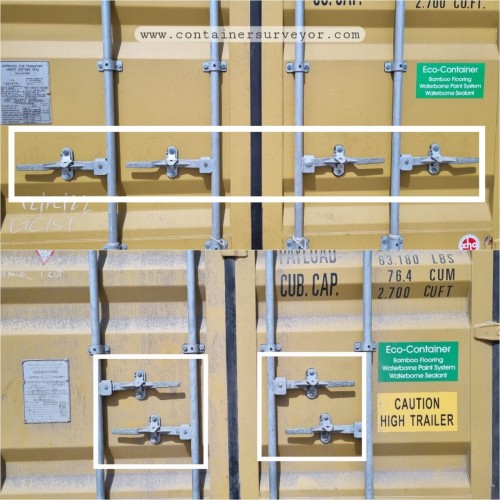
“Vertical Door Handle Arrangement”
The handles are vertically aligned, one above the other.
This is known as the “vertical locking handle pattern” or “standard symmetric door handle arrangement.”
Both handles are positioned roughly in line, giving a straight, upright appearance.
“Horizontal Door Handle Arrangement”
The handles are horizontally aligned, side by side.
This is often called the “horizontal handle pattern” or “parallel handle arrangement.”
03. How to Open a Shipping Container Door
Before attempting to open shipping container doors, safety must always come first. Taking the proper precautions and using the correct tools will help prevent injuries and equipment damage. Please also take note of the points discussed under point number 02.
When standing in front of the shipping container, always start with the right-side door unless a security seal is attached and needs to be checked first. Rotate the door handle retainers upward to release them, and repeat the same for the other handle. Then, push each door handle slightly toward the door, lift gently, and pull the handles outward toward you. This action disengages the locking bar cams from the locking bar cam keepers. Once both handles are released, pull them firmly to open the right-side door first, and then repeat the same steps to open the left-side door.
04. How to Open Container Step-by-step
- Stand facing the container and always start with the right-side door (unless a security seal must be checked first).
- If there is no intact security seal, rotate the door handle retainer upward to release it.
- Repeat the same action for the other handle retainer on the same door.
- Push the door handle toward the door, lift it slightly, then pull the handle outward toward you.
- Ensure this movement disengages the locking bar cams from the locking bar cam keepers.
- Once both handles are released, pull the handles firmly to swing the door open.
- After opening the right-side door, repeat the same sequence (retainer → push → lift → pull) on the left-side door.
05. How to Close the Shipping Container Door
Before attempting to close shipping container doors, safety must always come first. Taking the proper precautions and using the correct tools will help prevent injuries and equipment damage.
When standing in front of the shipping container, always start closing from the left-side door first. Hold both door handles and lift them slightly toward yourself until the locking bar cams properly engage with the locking bar cam keepers. Once the cams and keepers are fitted correctly, push both door handles toward the door to lock them in place. Then, press the handles gently downward and secure them into the handle retainers at the bottom. Close the door handle catches firmly to ensure both handles are locked. After confirming that both doors are properly aligned and secured, proceed to apply the container security seal.
06. How to Close Container Step-by-step
- When standing in front of the container, always start closing from the left-side door first.
- Hold both door handles and lift slightly toward yourself while closing until the locking bar cams properly engage with the locking bar cam keepers.
- Once the cams and keepers are properly fitted, push both door handles toward the door to lock them in place. Then, gently press the handle downward and secure it into the handle retainer at the bottom.
- Close the door handle catch to secure the handles firmly. After confirming both doors are properly closed and aligned, you may proceed to apply the container security seal.
07. Common Issues with Opening Shipping Container Doors
- Container positioned on uneven ground
- Locking bars jammed / dent / bent or lack of lubrication.
- Pressure build-up inside from temperature changes making doors hard to open. ( Specially rerefer containers )
- Rubber door seals becoming hard, sticky, or damaged over time.
- Hinges bent or corroded, preventing smooth movement.
- Cargo shifted during transit, pressing against the doors from the inside.
Disclaimer: The views expressed by the authors in this article do not necessarily reflect the views of CONTAINER SURVEYOR. Data and charts, if utilized, in the article have been sourced from available information and have not been authenticated by any statutory authority. The author and CONTAINER SURVEYOR do not claim it to be accurate nor accept any responsibility for the same. The views constitute only the opinions and do not constitute any guidelines or recommendation on any course of action to be followed by the reader.

